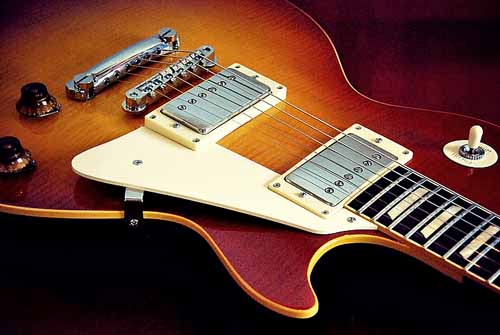Finding one of these vintage pickups can be both difficult and costly, but thankfully getting that same sound doesn’t have to be. Many companies now make their own version of Seth Lover’s iconic humbucker, and while many of them strive for their own unique sound, the selections below will give you the warmth and clarity the original PAF pickups became so well known for. These are the best PAF pickups currently available on the market.
Lindy Fralin Pure PAF
Even the most well-honed ear would have a difficult time telling a Lindy Fralin Pure PAF from an original 1950s Gibson PAF. Short of finding an antique original (and convincing its lucky owner to part with it), the Pure PAF (see full specs) is the best example of its kind. The magnets are hand-weakened to make the upper range less strident and smooth out the tonal quality overall. The end result is a powerful and articulate pickup that really shines when it’s played clean, making it ideal for jazz players and lighter rock styles.
https://www.youtube.com/gcnCd9KVXbQ
Gibson ‘57 Classic Plus Humbucker
The very first PAF pickups were designed for Gibson guitars (specifically the Les Paul) so it’s no surprise that one of the best modern PAF models is made by them, as well. They use the classic Alnico II magnet that you’d expect from a PAF. Unlike the original, the poles are wax potted to prevent feedback squeal and unwanted noise. The biggest variation between a 1950s PAF and the ’57 model is in the mid-range. The ’57 has a more pronounced low end than the original design that gives it a slightly warmer, bassier tone. It’s the among the best PAF pickups (well, PAF-styled pickups, if we want to be more specific) for players of driving rock or heavier music who want that PAF character with a bit more power.
Seymour Duncan Antiquity
You can find many companies that make their own version of a PAF-style humbucker, but with their Antiquity pickups Seymour Duncan takes it a step further, aging the magnet poles and covers to give them the sound that a 1950s PAF would have if you were to buy it today. Like the original PAF, the Antiquity is unpotted and uses an Alnico II magnet. The combination of these materials with the company’s high level of craftsmanship—each humbucker is hand-wound and hand-assembled—means you get a pickup with an exceptionally balanced tone and a sparkling harmonic resonance in the higher end that sounds great played both clean and with distortion.
https://www.youtube.com/E6Tprd6kf6g
DiMarzio 36th Anniversary Humbucker
Best for the bridge position (though it can also work in guitars with a hotter neck pickup) the 36th Anniversary humbucker uses modern technology to replicate the vintage PAF pickups of the ‘50s. It uses the nickel-silver base of the original PAFs and is styled for a vintage look, as well. The sound has more emphasis on the high end than most PAF replicas on the market. You can also split it into a single-coil mode if you want to change up your sound, which makes the tone brighter without having it feel thin or weak. No ifs and buts, this is one of the best PAF humbuckers for the money.
https://www.youtube.com/0KUcrO2ipbA
Materials
The original 1956 PAF pickups were made with either a stainless steel or nickel-plated brass cover. Both materials are good for their shielding properties, which helps to eliminate the hum that plagued single-coil models. The bottom plate is typically made of nickel silver because it’s non-magnetic and won’t disturb the pickup’s magnetic field.
All vintage PAF pickups were made using Alnico magnets, though Gibson experimented with a range of magnet strengths, anywhere from two to five, before settling on Alnico 5 magnets for their humbuckers in 1961. This variation in magnet strength is responsible for the tonal inconsistencies of the earliest PAF pickups. It also means the magnet is where you’ll find the most variation in modern PAFs.
Pickups that use an Alnico II magnet will have a smooth tone that adds a touch of warmth to your sound. Those that use an Alnico V will have a tighter low range with scooped mids and some bite and sparkle in the upper range.
One other important design feature of the original PAFs was the fact that the poles were unpotted. Wax potting is a process where the pickup components are soaked in melted wax, reducing the movement of the coils. Many modern pickups are potted because it prevents a lot of unwanted noise and feedback and also increases the durability of the pickup. On the flip side, a pickup that’s been potted can lose some of the edge and character from its sound.
Because some guitarists are looking for the unpotted sound out of PAF pickups, many of those that are designed to come as close as possible to the character of the originals will be unpotted (notably, the Seymour Duncan Antiquity listed above). Others will use a modern wax potting technique to eliminate microphonic squeal, and though this alters the character slightly from the original PAF tone, for many guitarists this minor concession is worth it to prevent their pickups from squealing when they get too close to the speakers on stage.
Who PAFs Are For
The best PAF pickups have a distinctive tone that many players treasure (there’s a reason vintage PAFs can go for thousands of dollars) but that doesn’t mean they will be the best pickup for every guitar. At the most practical level, not every guitar is routed to use PAF pickups without modification.
If your guitar can use other humbuckers, PAF models will fit, but if it’s routed for single-coil pickups (like many Fender models) you won’t be able to install PAF style pickups without some modification. PAF pickups have a warm, fat sound that’s excellent for most rock, folk, and jazz styles.
Aside from the feedback concern of unpotted pickups, PAFs are humbuckers that won’t produce a lot of extra noise, making them great for players who use a lot of sensitive dynamics. On the other hand, players of harder styles—like punk and metal—may find that PAF pickups make their tone too dark and don’t give them the bite they’re looking for.
Ultimately, as with any piece of musical equipment, the best way to tell if even the best PAF pickups are for you is to listen to some players using them, considering how they will fit into your overall sound. Good luck!








